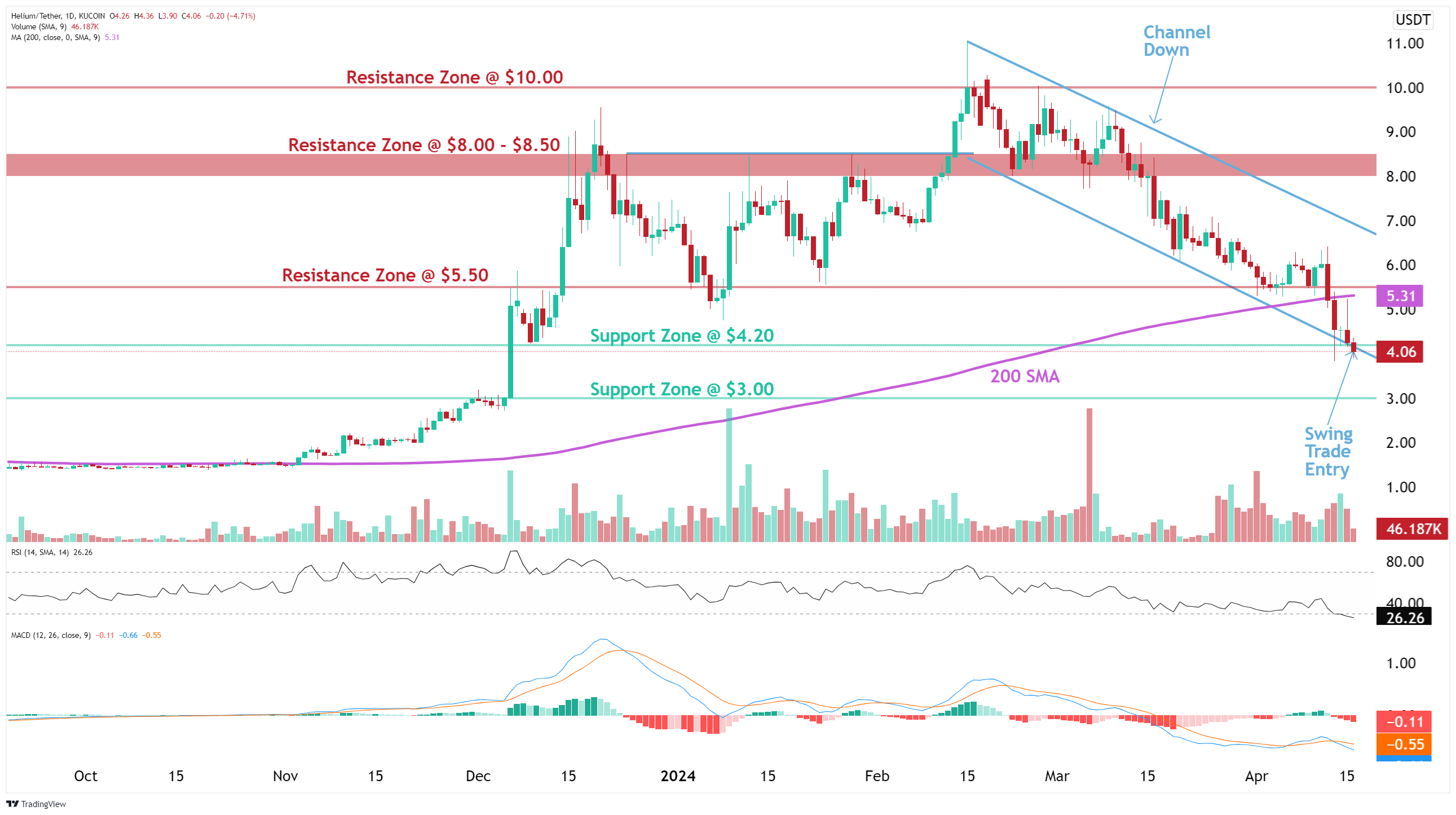Helium (HNT) Analysis
In addition to automated chart patterns, altFINS’ analysts conduct technical chart analyses of top 30 cryptocurrencies. We call these Curated Charts and they evaluate 5 core principals of technical analysis: Trend, Momentum, Patterns, Volume, Support and Resistance.
Helium (HNT) Trends
Helium (HNT) Performance
Helium (HNT) RSI & MACD
Helium (HNT) technical analysis:
Trade setup: Trends are mixed. After getting rejected at $10 resistance, price is trading in a Channel Down pattern. It’s also broken below 200-day moving average, which puts the long-term trend at risk. Trend traders: wait breakout from Channel Down and price to regain the 200-day MA level to signal resumption of Uptrend. Swing traders: price is near $4.20 support and is oversold (RSI ~ 30), hence, it could bounce up near-term. (set a price alert).
Pattern: Price is trading in a Channel Down pattern. With emerging patterns, traders who believe the price is likely to remain within its channel can initiate trades when the price fluctuates within its channel trendlines. With complete patterns (i.e. a breakout) – initiate a trade when the price breaks through the channel’s trendlines, either on the upper or lower side. When this happens, the price can move rapidly in the direction of that breakout.
Trend: Downtrend on Short- and Medium-Term basis and Neutral on Long-Term basis.
Momentum is Bearish ( MACD Line is below MACD Signal Line, and RSI is below 45).
Support and Resistance: Nearest Support Zone is $4.20, then $3.00. The nearest Resistance Zone is $5.50 (previous support), then $8.00 – $8.50, and $10.00.
 See live Helium (HNT) chart here
See live Helium (HNT) chart here
See more curated charts with technical analyses.
Recent news and research:
Nova Labs Introduces Revolutionary $5 Mobile Phone Plans in Miami
Mining Helium (HNT) in 2023: How to Get Started
Helium Ditches Own Blockchain in Favor of Solana After Community Vote
Helium’s Nova Labs now valued at $1.2 billion after fastest rollout in history
Bobcat Miner Launches Helium 5G Gateway to Mine HNT
HeliumRent Provides A New Way For Renting Helium Mining Hotspots
Helium Mining Hotspots fundraises $111mln and archives more than 100k active nodes.
Where to buy Helium: bull run continues, HNT reaches ATH
Find real-time news here.
What is Helium (HNT)?
Find full description and news on altFINS platform.
Overview
Helium is a decentralized, open wireless network built on a new blockchain for the physical world. It relies on a novel type of work called Proof of Coverage, and a new consensus algorithm (based on HoneyBadger BFT). The Helium Network is used to route data for long-range, lower power IoT devices that use Helium’s LongFi protocol
History
Helium was founded in 2013 by Shawn Fanning, Amir Haleem, and Sean Carey, with a mission to make it easier to build connected devices. Helium believes that today’s wireless connectivity options are wholely inadequate for the next generation of machines. To solve this they developed the Helium Hotspot, a combination of a physical blockchain node and wireless gateway that network participants can deploy to receive compensation in HNT, the native token. In order to receive rewards, Hotspots must submit proof of wireless coverage in a cryptographically verified location and time. Once the network is deployed, any sensor using the Helium LongFi wireless protocol can connect to the network which is intended for battery-powered devices sending small amounts of data over miles of range. Hotspots are rewarded in HNT based on the quality of the coverage they provide and the amount of LongFi sensor data they transport for devices on the network. HNT is burned to create Data Credits, a non-fungible token used for all transaction fees on the network. Data Credits are required for things like sending sensor data and asserting Hotspot location. Any LongFi-enabled IoT device can send data through any Helium Hotspot that’s providing coverage.
Technology
Helium relies on a Proof-of-Coverage where Hotspots assert their location according to their GPS coordinates, and other Helium Hotspots routinely challenge in order to prove their location. Knowing where, when and how strongly a signal was received allows for verification of the transmitter location. Hotspots are constantly challenged by the Helium blockchain to prove their coverage, and they carry a score that floats dynamically between 0.0 and 1. This score represents the Network’s confidence in their location as derived from those challenges, and thus the quality of their Helium LongFi wireless coverage Consensus is reached using the Helium Consensus Protocol. It works by having the best proofs of coverage from the prior epoch elect members for the next one who then runs a distributed key generator to bootstrap their threshold encryption keys. Each member accepts transactions until they have a certain amount in their queue, then encrypts them with the threshold public key and gossips encrypted data around. Once members all share their proposed transactions, they are all threshold decrypted at which point they cannot be censored. The transactions are deduplicated, invalid ones removed, and they are combined into a new block. This block then has a threshold signature applied to it. Members trying to censor transactions will end up with a different block than honest nodes and thus their signature shares won’t be valid. Helium provides coverage using LongFi, an open-source protocol in the Sub-GHz frequency band. Using LongFi any device can broadcast a message within the coverage area of the Helium network and have their message relayed to a web server for a fee.
